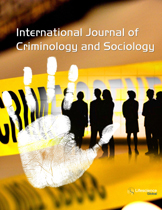ijcs
|
|
Abstract: This research attempted to clarify the determinants of registered sex offender violations using individual-level and contextual characteristics under social disorganization theory. Data on registered sex offenders in Fresno County, CA and census data were analyzed to examine the influences of offender characteristics, neighborhood disadvantage, and accessibility to social services on violation risks. Multilevel logistic regression models indicated that those offenders living in disadvantaged neighborhoods faced a higher risk of registration violations, while such an effect was mitigated by the accessibility to social services. Based on the findings, policy implications of social services as a protective factor and strategic management of the registration policies were discussed. Keywords: Registered sex offenders, neighborhoods, spatial analysis.Download Full Article |
|
|
Abstract: Weapon transfer stains in a crime scene are often difficult to interpret. Given the large number of hammer hit events that take place each year, this work is largely aimed at analyzing the different factors that influence and distort regular hammer transfer stains. Different physical mechanisms under identical conditions influence the formation of distinct transfer stain patterns. This is the basic highlight of this study. By experimentation, the authors are of the view that the quantity of blood attached to the surface area of a hammer, the surface area of the hammer exposed to blood, the dimensions of the hammer, the angle of inclination at the time of fall, hardness of the target surface, friction coefficient of the hammer material, texture of the target surface influence the transfer stain formed. Again the velocity of hit, the undulations in the hammer, the depth of blood pool, hammer weight all have significant effect on the transfer stain pattern formed. The significance of the height of fall and the edge that touches the target surface first, cannot be particularly ruled out in analyzing hammer transfer stain patterns. The relevance of the article lies in the fact that analysts having clear idea of how these different factors could affect the formation of different weapon transfer stain patterns, shall be in a better position at understanding the probable mechanism that might have led to the formation of the stain. This knowledge is transferable to the study of other murder weapon transfer stain interpretation and shall aid proper sequencing of segments in a criminal event. Keywords: Murder weapon, transfer stain, bloodstain pattern, hammer, head hit, free fall.Download Full Article |
|
|
Abstract: Restitution programs are widely used to hold offenders accountable for their actions while providing restoration to victims and community service. However, compliance with restitution requirements is a major problem, as reported by juvenile probation offices across the country. The Firewood Program was developed for juvenile probationers in a rural Pennsylvania county to improve the completion rate of restitution payments to victims and provide community service. This study examines the effectiveness of the restitution program, which was measured as an increase in the offender’s level of empathy and shorter completion times of restitution payments. Keywords: Restitution, community corrections, restorative justice, juvenile probation.Download Full Article |
|
|
Abstract: The effects of violence on the person are extensive, more so, for persons disabled through violence. Research in occupational therapy has shown the effectiveness of occupations in helping displaced refugees to construct new identities and navigate new ways of belonging within asylum countries. No research thus far has focussed on the role of occupation for healing in contexts of sustained violence. Aim: To explore the role of occupations in the healing journeys of people physically impaired by violence. Study Design: Qualitative; Narrative Inquiry. Methodology: Photovoice and Narrative Interviews. Data Analysis: Narrative-analytic methods were used to produce explanatory stories.Findings: These are presented with a specific focus on the impact/influence of violence on personal and societal occupational engagement and the restorative role of collective occupations within the participants’ healing journeys. The findings suggest a need to reframe violence as a collective occupation that dehumanizes, and healing as a collective process that (re)humanizes within a broader framework of Ubuntu as an interactive ethic. These findings call for a shift in focus for rehabilitation practices involving individuals disabled through violence, in contexts of sustained direct and structural violence such as South Africa. Keywords: Violence, context, disability, healing, occupation.Download Full Article |
|
|
Abstract: Coherence, the relationships which link the meanings of utterances in a discourse or of the sentences in a text, is realized on two levels: linear or sequential coherence and global semantic structure. Taking the audio recording transcripts of two trials (one criminal and one civil) as data, this paper analyzes coherence of Chinese courtroom discourse. The findings indicate that courtroom discourse is coherent semantically (there are meaning relations between different parts of the discourse), topically (different parts of the discourse accord with its general topic), contextually (different parts of the discourse mix with the context and accomplish the communication together), and historically (the discourse refers back to its history, i.e. preceding trials, etc). Keywords: Coherence, Chinese courtroom discourse, Meaning, Civil trial, Criminal trial.Download Full Article |



